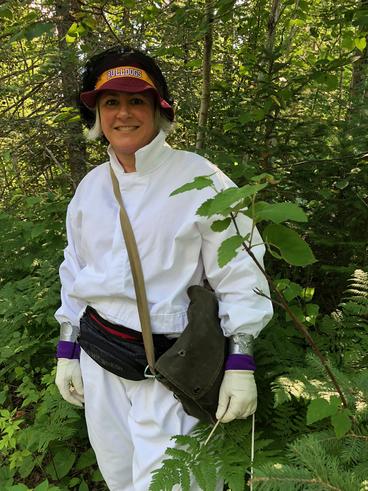The first thing Cole Fisher does after she gets out of the car is to pull on a white painter suit. She adds a hat and netting head gear and takes duck tape out of the trunk.
Next the sleeves of the suit get tucked in to the gloves at the wrist. Here's where the duck tape comes in. Cole seals the gloves to the painter suit with tape and then seals the legs of the suit over her shoes.
She's ready for the first evening "tick drag" at the Boulder Lake Environmental Learning Center.
Cole graduated from UMD with a double major in Cell and Molecular Biology and Biochemistry in 2016 and starts in the Master of Environmental Education program in fall 2018.
In the meantime she's a researcher for the School of Pharmacy and a student volunteer researcher for a Minnesota Department of Health (MDH) vector-borne diseases unit.
In the woods, she drags a white canvas behind her by a rope. Each time Cole gets to a marker on her path, she examines the canvas for ticks.
When the woods are moist and warm, there can be hundreds of critters. This evening the weather has been dry, so Cole only has a few tiny larvae to pick up with a tweezer and add to vials.
She takes the path down and back and prepares to move to the next section. She'll do 11 in all before she calls it quits.
The More We Know
"I'm fascinated by research on ticks/Lyme disease," Cole says. She started doing research as an undergrad with Dr. Benjamin Clarke in the Medical School Duluth and is currently helping him design a tick/Lyme study.
Last year, she was an independent contractor for the MDH and counted ticks for their phenology study at St. Croix State Park.
The current work at Boulder Lake contributes to the MDH research. "On the evenings and weekends, I volunteer whatever free time I can spare to studying ticks, the vector of Lyme disease."
The Study
Cole is collecting data the MDH will use to determine the population's risk to disease. The study looks at what kind of ticks are found, how many, and how many carry a tick borne disease.
The most common types are the deer tick (aka blacklegged tick) and the wood tick (aka American dog tick), which both can spread diseases. The deer tick is involved in the spread of Lyme disease.
"I wanted to stay involved this summer as I had put so much of my time into building my Lyme/tick research and there is still so much to do and learn. As the MDH wrapped up it’s St. Croix study and wanted to pilot a new study at Boulder Lake, I was keen to participate and keep involved."
Prevention
Understanding ticks goes a long way in preventing diseases. "A tick only feeds two or three times in their life cycle. They need blood from mammals like mice or deer to get nutrients first and then to reproduce," Cole says.
She has advice, such as wear light colors so you can see the ticks and tuck your pant legs into your socks. She urges people to "do a tick check when you come indoors," and dry the clothes you wore in a dryer on high heat for 10 minutes.
"Spending time in the woods in Minnesota is one of the best things to do in summer. Just be safe."
For more tips, see the State of Minnesota Department of Health.

